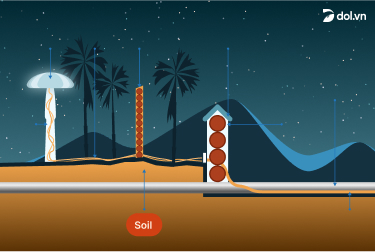Tutor:
So, let’s hear what you’re doing for your next project.
Student:
I’ve decided to design a roof garden for a supermarket. I’ve been looking at some on the web and I think that a garden on top of a building is the up-and-coming thing.
Tutor:
OK. So you’ve done a bit of reading already? What benefits would there be for the client? Why do you think a supermarket chain would be willing to meet the expense of construction? You do realize that would be the first thing they raise.
Student:
Yes, I know. But I’d explain that in spite of the initially high expense, they would save that much in approximately five years. Well, I’d have to do sums, I mean calculate specifically…
Tutor:
Yes, how would the saving come about?
Student:
Mainly through lower heating and aircon bills. The extra insulation offered by having a layer of living plants in the soil would make a huge difference.
Tutor:
OK. But they might feel the expense of maintenance would be an issue. After all, supermarkets don’t normally employ gardeners.
Student:
What I thought was, if they made it a community garden rather than a simple low-maintenance green roof….
Tutor:
So there’d be public access?
Student:
Oh yes! Then there’d be a sense of ownership in the local community and people could take responsibility for it, instead of the supermarket paying a commercial company, and It’d really boost their public relations.
Tutor:
That’s a good point. And have you been looking into how rook gardens are built nowadays?
Student:
I’m still exploring that, but if take advantage of the latest technologies for roof gardens, it shouldn’t be too difficult. But in any case, you have to use lightweight materials.
Tutor:
But that’s a matter of making the right choices. You can even use quite traditional ones such as wood for the planting areas.
Student:
Yes, that’s what I thought. It’ll look good and it isn’t too heavy.
Tutor:
But the basic construction, the issue you have to address first is the material used between the building and the garden.
Student:
You mean the barrier fabric, which ensures there’s no chance of rainwater leaking down into the building?
Tutor:
Yes, nowadays that is very good, and quite easily sourced.
Student:
Then on the other hand, there’s the business of water within the roof garden itself.
Tutor:
You mean drainage? That’s an important feature of the construction in any roof design.
Student:
Yes, but I think most drainage issues have been well understood for quite a long time.
Tutor:
OK, but another thing is with plants in an exposed situation, you usually need to find ways to optimize rainfall.
Student:
Yes, because rainwater is best for the garden, if you can store it for when it’s needed. What I’ve been looking at are some buildings which use fairly conventional storage tanks, the kind that have been in use for decades, but have them linked to modern automatic watering systems.
Tutor:
Sounds complicated.
Student:
It’s less so in practice than it sounds, I think. I’ve been researching them and actually the latest ones definitely work very well and they can be electronically regulated to suit the local microclimate.
Tutor:
Mmm, that sounds interesting. You seem to have been doing some thorough research! Make sure you reference all your sources when you write it up.
Student:
Yes, sure. Um, there’s one more aspect I’d just like to run past you, if there’s time? I want to include a light feature in the design.
Student:
I’ve got a sketch here.
Tutor:
Let’s have a look then.
Student:
Well, I was really impressed by something I saw on a roof in Cornwall and I’d like to design something similar. Um, you have an area of planting, and I'm thinking of installing this lighting in an area filled with low-growing evergreen shrubs.
Tutor:
Mmm. You’d have to have lights and things well away from anywhere children might be. How would it work? On this drawing, this is a section view? You have this low wall on the right?
Student:
Yes, that’s it. This is just one element and these areas would be repeated all round the planted area. I think this will probably be a wooden wall, using reclaimed timbers, with an angled ceramic top surface.
Tutor:
Perhaps even ridge tiles like they use on roofs?
Student:
Oh, yes, that’d be just the sort of thing. And that’d make it waterproof. Um and then the heavy duty electric wiring comes up through the floor just outside the planted area and into the wall. Then it’s brought through a projector low in the side of the wall, and that sends a beam of light along the fibre optic cable.
Tutor:
So there’s no electricity in the actual lights. It's in the actual lights. The fibre optic goes across the surface of the soil in the planting area.
Student:
Yes, that’s the beauty of it. The shrubs will soon grow to cover it up, of course, and then the cable goes past a wooden post which is between the shrubs, and can be a support for them as they grow bigger, and then runs up into each element of the installation.
Tutor:
So the light beam is carried up to the top of each element and illuminates a kind of conical glass cap? I see! Is that the bit which would glow in the dark?
Tutor:
And what’s the cap supported on? Is it a wall?
Student:
No, it’s a slender acrylic rod, er, like the stem of a flower or mushroom, which the cable runs up inside of.

 Mình cần nghe xem đâu là 2 lý do mà người ta có thể phản đối về roof garden
Mình cần nghe xem đâu là 2 lý do mà người ta có thể phản đối về roof garden Tutor hỏi: "Why do you think a supermarket chain would be willing to meet the expense of construction? You do realize that would be the first thing they raise"
Tutor hỏi: "Why do you think a supermarket chain would be willing to meet the expense of construction? You do realize that would be the first thing they raise" 


